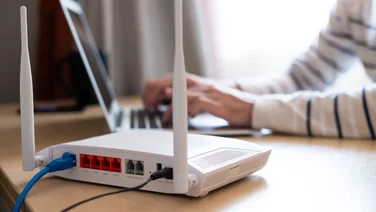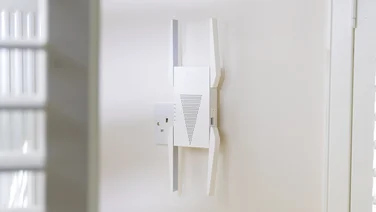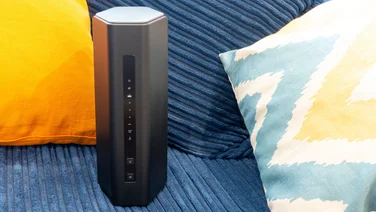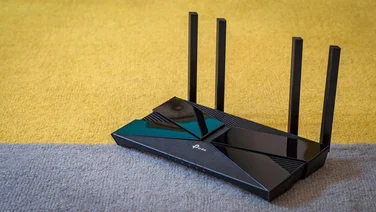To help us provide you with free impartial advice, we may earn a commission if you buy through links on our site. Learn more










- Cheapest Wi-Fi 7 router we’ve seen
- Consistent performance and coverage
- Easy app-based setup and management
- Basic hardware and features
- Less bandwidth than pricier options
Keeping up with the latest advancements in wireless router technology can be expensive, but the Netgear Nighthawk RS100 bucks that trend. After debuting its Nighthawk RS700S Wi-Fi 7 router at a steep price of £800, Netgear followed it with the £245 Nighthawk RS300 and cut prices further with the Nighthawk RS200 at £200. The Netgear Nighthawk RS100 on trial here delivers the coup de grâce: a bona-fide Wi-Fi 7 router that’s currently available online for just £130.
Needless to say, the hardware isn’t as powerful as Netgear’s upmarket models. Performance on the 5GHz band doesn’t match up to the more expensive variants, and there’s no 6GHz radio at all.
Even so, the RS100 is faster than most Wi-Fi 6 routers we’ve tested, and it’ll probably have a longer support lifespan ahead of it. If you’re looking for Wi-Fi 7 on a limited budget, it’s the best option we’ve seen so far.
Netgear Nighthawk RS100 review: What you need to know
The Nighthawk RS100 incorporates the two core technologies that define Wi-Fi 7 – namely 4K QAM encoding, which packs 20% more data into the same airtime as Wi-Fi 6, and a dynamic frequency-adjusting feature called preamble puncturing, which reduces the impact of interference from neighbouring networks.
The onboard radios aren’t particularly fast, however. The RS100 uses 2 x 2 MIMO to achieve a maximum data rate of 2.9Gbits/sec on the 5GHz band – half the speed of the RS200 – and, as we’ve mentioned, there’s no 6GHz radio.
The multi-link operation feature introduced in Wi-Fi 7 isn’t implemented either, so you can’t combine the 2.4GHz and 5GHz bands into one accelerated link. And rather than embracing the new 320MHz channel width, the Netgear Nighthawk RS100 sticks with the last-generation maximum of 160MHz. In short, you’re getting a basic Wi-Fi 7 service, with none of the optional enhancements.
Wired networking is quite barebones, too. The RS100 can support a 2.5GbE internet line, but its LAN sockets are all limited to gigabit speeds, and there’s no USB port for sharing external storage. Even the system software has been slightly pared down from what we’re used to from Netgear.
Price and competition
The Nighthawk RS100 currently costs £130 at Amazon, considerably less than any Wi-Fi 7 router we’ve previously tested. However, if you don’t need the latest wireless standard there are plenty of cheaper options.
Our recommended Asus RT-AX59U now costs just £92 at Amazon and remains a great little Wi-Fi 6 router, with twin USB ports and free integrated parental controls and security features.










Within the Wi-Fi 7 market we haven’t so far tested anything else in the RS100’s price range – but, as we’ve noted above, Netgear does offer a whole stack of progressively pricier options. The Netgear Nighthawk RS200 is similar to the RS100 but features a faster 5GHz radio, while the Netgear Nighthawk RS300 includes a high-bandwidth 6GHz transmitter. At the top of the stack, the Nighthawk RS700S offers the highest speeds available over all three frequency bands, along with 10Gbits/sec wired networking and a year of network security services bundled in.
If that’s not enough of a selection for you, Netgear also offers Nighthawk RS500 and RS600 models – we haven’t reviewed these, but the specification sheets suggest they’ll likely offer in-between performance levels as implied by their model numbers. Curiously, there’s no Nighthawk RS400.
Design and features
I’m not sure I’ve ever been tempted to call a router “cute” before, but if you stand the Nighthawk RS100 next to the towering RS700S – or even one of the mid-sized RS200 or RS300 models – it definitely looks like the baby of the family. I don’t mind this at all: all things being equal, I prefer a compact design that’s easy to tuck away. Despite its small stature, Netgear recommends the RS100 for homes of up to 185 square metres, which is considerably bigger than the average UK domicile.
The small format does come with some compromises, however. There’s no USB port, so you can’t use this router to easily share files over your local network, or over the internet. And while you can connect a multi-gigabit broadband line to the 2.5GbE WAN port, the lack of 2.5GbE connectivity on the LAN side means you can forget about super-fast local networking.










A final cost-cutting measure is that, in place of the elegant light-up icons found on other Netgear routers, the RS100 uses big glowing block LEDs with labels printed next to them on the casing. Naturally, this has no impact on performance, but it looks a little cheap in comparison. There’s also no button to turn the LEDs off, as found on other models, although you can achieve this from the management interface. The bottom LED segment doubles as a push-button, to temporarily enable WPS for password-free connection.
Setup could hardly be easier, thanks to Netgear’s familiar Nighthawk mobile app: you just need to scan the QR sticker with your phone, then enter your preferred network name and security settings. The most tiresome part is having to wait around for the router to reboot after you’ve configured its initial settings (and reconnect if you’ve changed its default SSID or password).










After this, you can use the app to easily monitor which devices are connected to your network, manage your network configuration and try out the useful analytics module, which scans the airwaves and reports on signal strength and channel contention, to help you find the ideal location and settings for your router. You can also activate Netgear’s add-on Armor security service, which includes Bitdefender client security software and outbound VPN services – although you only get a 30-day trial, after which the service costs £85/yr.
More technical settings are offered within a browser-based administration portal. As usual with Netgear this is helpfully divided into “Basic” and “Advanced” views, but the settings themselves are annoyingly spaced out, so exploring the available options involves a lot of tedious scrolling up and down.










Still, there’s a good degree of configurability on hand. You can split up the wireless signal into separate 2.4GHz and 5GHz networks, enable guest networks on either or both bands, tweak your DNS settings and set up port forwarding and triggering.
There are just two features notably missing. One is the parental control module. Netgear routers usually require an add-on subscription to activate content blocking and activity monitoring, but the RS100 doesn’t even include the basic time-limiting features that are included for free with the RS200 and other models. The standard inbound VPN server is absent here, too. If you want to securely connect to your home network over the internet, you’ll need to make your own arrangements.
Performance
I’ve mentioned that the RS100’s 5GHz radio claims a top speed of 2.9Gbits/sec – only half the rate of the RS200. Such figures can be misleading, however: the download rates you see in the real world are affected by a lot of factors, of which nominal link speed is but one.
Because the numbers in the specifications don’t tell you the real world speeds you can expect from your wireless router, we test every router we review in real world conditions, setting up the router in a consistent position, then measuring upload and download speeds using a laptop at various locations around a standard UK home.
You can read more about what we look for and how we test wireless routers by reading this article.
To see how to the Nighthawk RS100 actually measures up to its bigger, beefier brethren, therefore, I set about testing the router in an real world setting: my home. I plugged an Asustor Drivestor 4 Pro NAS appliance to one of the router’s gigabit LAN ports, and connected to the router’s 5GHz network from a laptop equipped with an Intel BE200 Wi-Fi 7 card. I then carried this laptop to various rooms around the house, and in each location I measured upload and download speeds when copying files to and from the NAS.
Here are the results I saw, along with the 5GHz speeds I’ve seen from other Netgear Wi-Fi 7 routers for comparison – plus our favourite Wi-Fi 6E router, the Asus RT-AXE7800:
Predictably, the Nighthawk RS100 can’t keep up with its more expensive siblings. While it fared unexpectedly well in the dining room, it trailed the pack overall. In most locations it didn’t even match the Nighthawk RS300, which has the same 2.9GHz speed rating on the 5GHz band. That’s likely because the RS300 has a larger antenna array, and a wider claimed coverage area of 230 square metres.
Let’s not forget either that three of these four rivals feature 6GHz radios, adding extra bandwidth and boosting short-range speeds – in our full review of the Nighthawk RS700, we saw download rates as high as 156.9MB/sec.
As I’m always saying, however, context is everything. The graph above doesn’t include figures for our recommended Wi-Fi 6 router, the Asus RT-AX59U, as this was tested a different location – but as our original review reveals, the very best download speed we saw from that router was 86.3MB/sec, dropping to around 35MB/sec over a distance of one or two rooms, and right down to 13.6MB/sec at the far end of the house. Next to that, the RS100’s performance doesn’t look too shabby at all.
Remember too that, while Wi-Fi performance keeps edging upwards, the demands of video streaming and chat services have barely changed in years. Disney+ is still recommending a 25Mbits/sec connection for 4K HDR content, which is equivalent to less than 4MB/sec. This means that, even if you have several family members wanting to simultaneously stream maximum-quality video in different rooms, the Netgear Nighthawk RS100 can handle the load without breaking a sweat. Indeed, it will happily serve up the exact same media experience that you’d get from a Nighthawk RS300 costing twice as much, or from a top-tier Nighthawk RS700S router.
Netgear Nighthawk RS100 Wi-Fi 7 router review: Verdict
I’ve previously praised the Nighthawk RS200 for offering a decent Wi-Fi 7 experience while keeping the budget tight. The Nighthawk RS100 is even more ambitiously economical, cutting out almost every extraneous feature while retaining a solid, practical baseline level of performance and connectivity.
I don’t need to reiterate that other routers are faster and more versatile, but I’d recommend you seriously ask yourself whether the extra speed and features are really worth the spondulicks. If you want to download large game files over the internet as quickly as possible, or smoothly exchange files back and forth with a local NAS appliance, then perhaps they are.
Or, another reason to choose a more expensive Wi-Fi system might be if you want multiple devices to get top performance all at once. High-end routers invariably offer more total bandwidth, thanks to features such as 4×4 MU-MIMO and additional 6GHz radios.
If we’re being honest, though, for the vast majority of typical households the limitations of the Nighthawk RS100 will be negligible or unnoticeable. Personally, I’d have no problem at all running my own home network on this router. It won’t be perfect for everyone, but if you’re at all interested in moving up to Wi-Fi 7, the RS100 ought to be the first router you consider.






